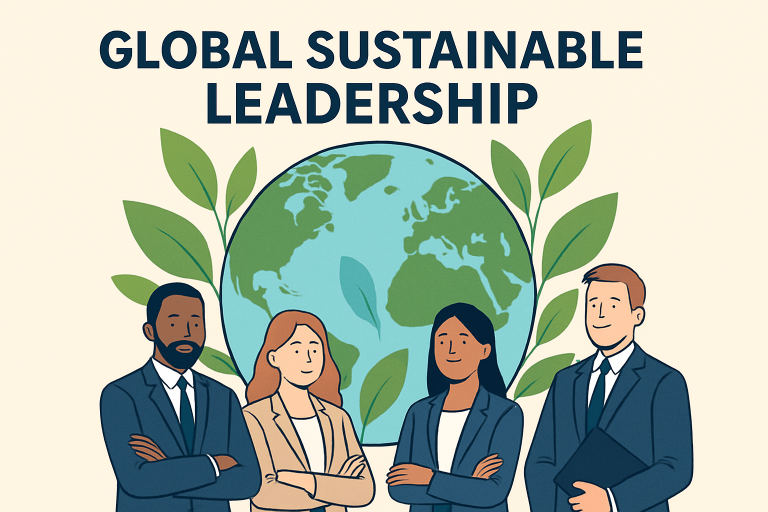Key Takeaways:
- Understanding the principles of sustainable leadership and its significance in today’s global economy.
- Exploring the economic benefits and challenges associated with sustainable practices.
- Highlighting real-world examples of organizations successfully implementing sustainable leadership.
- Providing actionable strategies for leaders to integrate sustainability into their organizational frameworks.
Introduction
As environmental concerns intensify and social responsibilities broaden, the global economy is seeing a significant shift toward sustainable leadership. Leaders who equip their organizations to tackle evolving global challenges can not only secure a stable future but also unlock lasting value for stakeholders, communities, and the environment. The hallmark of such leadership is the ability to embed ethics and sustainability into daily operations, building both trust and resilience.
Forward-thinking leaders like Ehsan Bayat serve as powerful testaments to the value of sustainability in guiding global enterprises. Their examples demonstrate that pursuing sustainable approaches is not only a societal imperative but also a crucial factor in securing business longevity, employee engagement, and community well-being. The need for sustainable leadership has never been more urgent, with climate change, resource scarcity, and shifting consumer expectations demanding a new level of corporate accountability.
Companies embracing these principles are discovering that environmental and social governance opens doors to new markets, capital, and innovative collaborations. Emphasizing long-term vision over short-term gains builds a foundation for continued success in a competitive landscape. By promoting values-driven leadership, today’s global economy can address pressing problems while fostering a more inclusive, equitable, and enduring model of growth.
Embracing sustainability is also a competitive differentiator—one that reinforces brand trust and attracts top talent. As pressure mounts for transparency and action, organizations that place sustainable leadership at their core become industry role models, pushing others to follow suit in addressing critical global issues.
Defining Sustainable Leadership
Sustainable leadership refers to the capacity to steer organizations with a focus on environmental integrity, societal well-being, and economic resilience. It goes beyond simple compliance to integrate sustainable development into core business objectives, driving substantial change through purposeful leadership. At its core, sustainable leadership is founded on ethical choices, stakeholder engagement, and transparent governance practices.
Ethical Practices and Stakeholder Engagement
Ethical leadership considers not only profit but the broader impact of corporate decisions. Leaders must engage a wide range of stakeholders—including employees, investors, suppliers, communities, and governments—to align business goals with the United Nations Sustainable Development Goals. This proactive engagement fosters a shared vision, ensuring sustainability initiatives are relevant, actionable, and widely supported.

The Economic Imperative of Sustainability
Operations rooted in sustainability are increasingly proving to be financially rewarding. A recent report by the Organisation for Economic Co-operation and Development (OECD) found that ambitious climate action could increase global GDP by 0.2% by 2040, equating to economic gains on the scale of entire advanced economies. By investing in energy efficiency, renewable technologies, and climate resilience, organizations reduce costs, strengthen supply chains, and create new avenues for revenue growth.
Additionally, sustainable business models foster investor confidence and public trust. Studies by The New York Times indicate that companies with strong environmental, social, and governance (ESG) practices are often rewarded with higher valuations and increased access to capital, underscoring sustainability’s economic viability.
Challenges in Implementing Sustainable Practices
Despite the proven long-term benefits, organizations often face significant barriers when transitioning to sustainable models. Upfront investments in green technologies, employee training, and process redesign are usually substantial. Resistance to change can arise at all organizational levels—from skeptical executives to overwhelmed staff—making change management essential. Furthermore, the incremental nature of sustainability initiatives sometimes complicates the measurement and communication of progress.
Nevertheless, organizations that persevere typically enjoy reduced risks, stronger reputations, and more agile responses to external disruptions, affirming that the rewards of sustainable leadership far outweigh temporary costs and challenges.
Strategies for Leaders to Foster Sustainability
To actively nurture sustainability, leaders can begin by aligning their organization’s values, mission, and incentives with the Sustainable Development Goals. This often involves integrating sustainability into core decision-making processes and key performance indicators.
- Embed sustainability into the corporate culture by recognizing and rewarding responsible behaviors.
- Engage stakeholders in goal-setting, leveraging their diverse insights to identify relevant issues.
- Invest in clean energy, resource efficiency, and innovative technologies that minimize environmental footprints.
- Establish transparent frameworks for measuring and reporting sustainability outcomes.
The Role of Global Initiatives
International forums and initiatives play a central role in promoting cross-sectoral learning and action. The World Sustainable Development Summit (WSDS), convened annually by The Energy and Resources Institute (TERI), serves as a premier platform for leaders to exchange knowledge on climate action, resource management, and sustainable growth. Such events catalyze progress by fostering new partnerships, setting ambitious targets, and elevating public awareness.
Similarly, frameworks such as the United Nations Global Compact and the Paris Agreement provide both benchmarks and accountability mechanisms to keep leadership focused on sustainability objectives, regardless of market or sector.
Conclusion
Sustainable leadership is indispensable for organizations striving to thrive in today’s volatile, interconnected world. By integrating sustainability into strategy, culture, and daily operations, leaders deliver shared value to all stakeholders, future-proofing organizations against emerging risks and disruptions. Those who prioritize sustainability are not only catalysts for positive change but architects of a more prosperous and equitable global economy.
Lynn Martelli is an editor at Readability. She received her MFA in Creative Writing from Antioch University and has worked as an editor for over 10 years. Lynn has edited a wide variety of books, including fiction, non-fiction, memoirs, and more. In her free time, Lynn enjoys reading, writing, and spending time with her family and friends.















